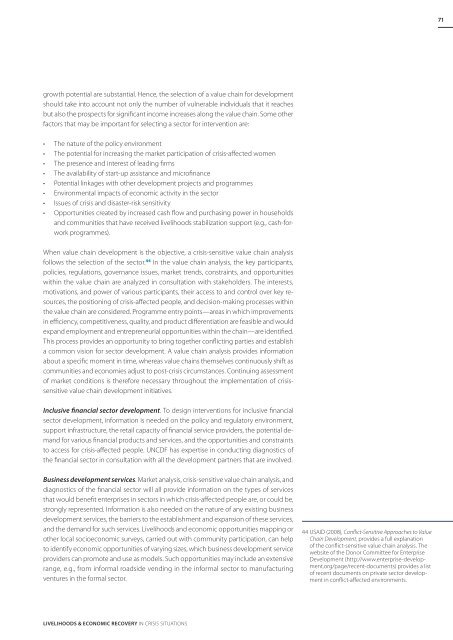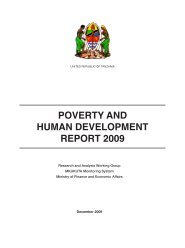Download PDF (4.08 MB) - ReliefWeb
Download PDF (4.08 MB) - ReliefWeb
Download PDF (4.08 MB) - ReliefWeb
You also want an ePaper? Increase the reach of your titles
YUMPU automatically turns print PDFs into web optimized ePapers that Google loves.
71<br />
growth potential are substantial. Hence, the selection of a value chain for development<br />
should take into account not only the number of vulnerable individuals that it reaches<br />
but also the prospects for significant income increases along the value chain. Some other<br />
factors that may be important for selecting a sector for intervention are:<br />
• The nature of the policy environment<br />
• The potential for increasing the market participation of crisis-affected women<br />
• The presence and interest of leading firms<br />
• The availability of start-up assistance and microfinance<br />
• Potential linkages with other development projects and programmes<br />
• Environmental impacts of economic activity in the sector<br />
• Issues of crisis and disaster-risk sensitivity<br />
• Opportunities created by increased cash flow and purchasing power in households<br />
and communities that have received livelihoods stabilization support (e.g., cash-forwork<br />
programmes).<br />
When value chain development is the objective, a crisis-sensitive value chain analysis<br />
follows the selection of the sector. 44 In the value chain analysis, the key participants,<br />
policies, regulations, governance issues, market trends, constraints, and opportunities<br />
within the value chain are analyzed in consultation with stakeholders. The interests,<br />
motivations, and power of various participants, their access to and control over key resources,<br />
the positioning of crisis-affected people, and decision-making processes within<br />
the value chain are considered. Programme entry points—areas in which improvements<br />
in efficiency, competitiveness, quality, and product differentiation are feasible and would<br />
expand employment and entrepreneurial opportunities within the chain—are identified.<br />
This process provides an opportunity to bring together conflicting parties and establish<br />
a common vision for sector development. A value chain analysis provides information<br />
about a specific moment in time, whereas value chains themselves continuously shift as<br />
communities and economies adjust to post-crisis circumstances. Continuing assessment<br />
of market conditions is therefore necessary throughout the implementation of crisissensitive<br />
value chain development initiatives.<br />
Inclusive financial sector development. To design interventions for inclusive financial<br />
sector development, information is needed on the policy and regulatory environment,<br />
support infrastructure, the retail capacity of financial service providers, the potential demand<br />
for various financial products and services, and the opportunities and constraints<br />
to access for crisis-affected people. UNCDF has expertise in conducting diagnostics of<br />
the financial sector in consultation with all the development partners that are involved.<br />
Business development services. Market analysis, crisis-sensitive value chain analysis, and<br />
diagnostics of the financial sector will all provide information on the types of services<br />
that would benefit enterprises in sectors in which crisis-affected people are, or could be,<br />
strongly represented. Information is also needed on the nature of any existing business<br />
development services, the barriers to the establishment and expansion of these services,<br />
and the demand for such services. Livelihoods and economic opportunities mapping or<br />
other local socioeconomic surveys, carried out with community participation, can help<br />
to identify economic opportunities of varying sizes, which business development service<br />
providers can promote and use as models. Such opportunities may include an extensive<br />
range, e.g., from informal roadside vending in the informal sector to manufacturing<br />
ventures in the formal sector.<br />
44 USAID (2008), Conflict-Sensitive Approaches to Value<br />
Chain Development, provides a full explanation<br />
of the conflict-sensitive value chain analysis. The<br />
website of the Donor Committee for Enterprise<br />
Development (http://www.enterprise-development.org/page/recent-documents)<br />
provides a list<br />
of recent documents on private sector development<br />
in conflict-affected environments.<br />
Livelihoods & Economic Recovery in Crisis Situations





